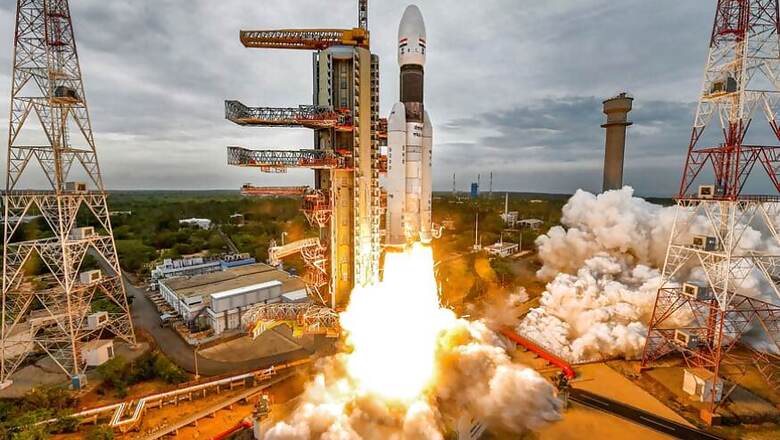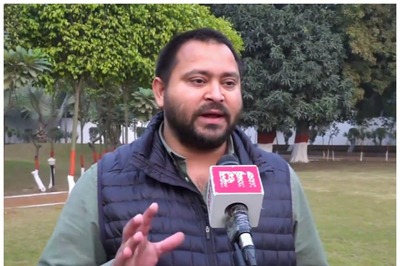
views
"During the second phase of descent, the reduction in velocity was more than the designed value. Due to this deviation, the initial conditions at the start of the fine braking phase were beyond the designed parameters. As a result, Vikram hard landed within 500 m of the designated landing site."
Wrought in technical jargon, this is the answer placed before the Lok Sabha on the functioning of Chandrayaan-2. It reveals little on what exactly went wrong with the lunar-craft that ambitiously aimed at landing India's first lander and rover on the moon's surface in September.
Launched on July 22, Chandrayaan-2 had onboard a lander named 'Vikram’ and a rover named 'Pragyaan', both of which were to be taken in a controlled manner to land on the moon's surface on September 7. However, Vikram (carrying the rover within it) failed to land at its destination and lost contact minutes after its controlled descent was triggered and is said to have crashed onto the moon's surface off-target. The lander was named after Vikram Sarabhai, India's space pioneer.
"Most of the components of Technology demonstration, including the launch, orbital critical maneuvers, lander separation, de-boost and rough-braking phase were successfully accomplished," the statement placed before Parliament reads.
This is the first official statement on what went wrong with the moon-lander that kept the entire nation hooked two months ago.
So what could have actually gone wrong?
"Actually, you just can't conclude anything based on that information," says Ajay Lele, senior Fellow at the Institute of Defence Studies and Analyses. "There are two or three broad options. It could be a mechanical failure, or a problem with controlling the velocity, or a problem with the firing of the engines. A fourth option could be that they were not prepared for some eventuality that could have happened," he added.
Former ISRO scientist Dr Mukund Rao points out that the specific sentence “reduction in velocity was more” points to the real problem of Chandrayaan-2's 'Vikram' lander soft-landing phase. It clearly shows that the lander slowed down faster than envisaged and “touched-down” on lunar surface much ahead from the landing point, naturally hard on the surface.
When the velocity/speed should have reduced gradually ideally, it dropped speed too fast and could not make the soft-landing. "Basically it lost velocity much faster and stopped much ahead, half a kilometer from its designated point. In common parlance, “braking” was too hard and it would have been a “rough” coasting to land hard. But the question is why did that happen? Why did velocity reduce much faster? Were such conditions anticipated and were there any correction mechanisms planned in the mission?” asks Dr Rao, currently an Adjunct Professor at the National Institute of Advanced Studies.
According to Rao, there are few key things to look at for the Vikram's missed landing -- the thrusters (akin to braking system) and control/guidance systems did not function as per plan. It looks like they “over-worked” and thus failed to make the soft-landing path; the lunar gravitation forces need to be well understood and modelled into the landing, especially at South Pole. Sufficient gravity and other data and their analyses are essential; the real-time and precise/detailed knowledge of the lunar terrain at landing area and their real-time modelling into the trajectory and velocity management. These aspects must have been looked into to understand the problem in more detail,” he said.
He added that the mission was a learning experience. "Technically, it is clear that, we need to certainly gain more knowledge, understanding and experience for lunar (and planetary) landing. Maybe, India needs detailed studies and modelling into these in depth. Velocity management in difference operations and scenarios of planetary missions, landing missions and human space flight missions is a very critical knowledge area and one has to be precise, accurate and perfect in controlling and managing velocity and any gaps can impact the mission. But it is a learning; one has to go through the steps and improve. Like a professional and good automobile driver… it has to be a good car, experience of driver and good knowledge of the road. That’s what makes the journey very perfect."
To that extent, he says perhaps more studies, reviews and consultations with other space agencies would be useful.
"Spacecraft landing, much heavier ones, has been repeatedly and successfully done by few other nations in the world, right from the late 1960s. We are now doing this operation. We can easily leap-frog by learning from others. So I feel, frequent 2-way scientist-level and programme-level collaborations and consultations on technical conferences on planetary missions and human space flight with US, Russia, Japan are extremely useful and critical for India. We can learn all of it and much faster, thus making good for our future missions," he says.
The NASA sent up the Apollo 11 with a crew to the moon way back in 1969 and has sent up 16 missions since then.
But ISRO, of course, will also learn from its own experience. Lele points out that though the Vikram failed its path, the space agency is now planning a Chandrayaan-3, possibly by November 2020.
"If they are already planning for another mission, it means they have identified the fault, so 100 per cent they know what went wrong. Or they wouldn't plan the next mission. They usually come out with the final report of the fault-finding committee. Once that is published, we will know exactly what went wrong," he says.
The answer in the Lok Sabha, which was a reply to a question by BJP MP Kirti Vardhan Singh, only says that the objectives of Chandrayaan-2 were two-fold -- 1) Scientific studies through payloads on-board the orbiter; and 2) Technology demonstration of soft landing and roving on the lunar surface.
The answer is silent on experiments that were to be carried out through the lander and the rover.
Interestingly, Singh’s question was pertaining the specifics. "The reasons for the failure of the Vikram Lander to land smoothly on the surface of the Moon?" the MP had asked.
Another similar query, by MP Kanakmal Katara, got vaguer answers.
Katara had asked "(a) Whether the Government has any data to assess the progress of Chandrayaan-II mission; (b) If so, the details of the progress of this mission; (c) The amount spent by the Government on this mission; (d) Whether any assistance was sought from other countries to make this mission successful; and (e) If so, the details thereof?"
Katara's questions were only answered thus: "(a) Yes Sir. (b) Orbiter has been functioning normal. The payload and bus systems are performing as planned. Scientific instruments are providing useful scientific data as planned. (c) Rs. 603 Crores. (d) No. (e) Not applicable."
There was no mention of ‘Vikram’ in this statement in the Lok Sabha. Both replies were tabled on Wednesday.
ISRO is also preparing for 'Gaganyaan’, the human space flight mission to launch by 2022. The work to select astronauts for this mission has already begun along with other project requirements.
According to experts, there is more complex knowledge of orbits, velocity management, life-support, re-entry, ejections etc involved to execute Gaganyaan. This requires tremendous modelling, deep understanding of fundamental physics, high-level math and modelling and limit-less computing simulations. For Gaganyaan, the one and only mission success criteria would be to get the astronauts back to Earth safely, requiring safe earth-escape; provide for their secure life support systems in space and execute perfect re-entry systems.
The experts agree that, towards this, a third Chandrayaan mission is most prudent and critical. A flawless execution of lunar landing would tremendously give confidence and scientific achievement and richly enhance our knowledge-base for future space successes.




















Comments
0 comment